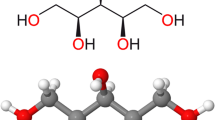Abstract
Oral doses of pilocarpine increase salivary flow rates in patients afflicted with xerostomia (dry mouth). This study examined the pharmacokinetics of and a pharmacodynamic response (salivation) to intravenous pilocarpine nitrate administration in dogs. Disposition was linear over a dose range of 225–600 µg/kg; plasma concentrations were 10–120 µg/L. Elimination was rapid and generally biphasic, with a terminal elimination half-life of approximately 1.3 hr. The systemic clearance of pilocarpine was high (2.22 ± 0.49 L/kg/hr) and its steady-state volume of distribution (2.30 ± 0.64 L/kg) was comparable to that of many other basic drugs. All doses of pilocarpine induced measurable submaxillary and parotid salivary flow rates which could be maintained constant over time. Cumulative submaxillary saliva flow was linearly related to total pilocarpine dose. Plasma pilocarpine concentration was linearly related to both steady-state and postinfusion submaxillary salivary flow rates.
Similar content being viewed by others
REFERENCES
L. M. Sreebny and A. Valdini. Xerostomia, a neglected symptom. Arch. Intern. Med. 147:1333–1337 (1987).
I. D. Mandel. The functions of saliva. J. Dent. Res. 66(Supp.):623–627 (1987).
Anonymous. Dry mouth—a problem for your older patients. Drug Topics 131:26 (1987).
K. A. Baker and R. L. Ettinger. Intra-oral effects of drugs in elderly persons. Geriodontics i:111–116 (1985).
N. L. Peters. Snipping the thread of life. Arch. Intern. Med. 149:2414–2420 (1989).
I. D. Mandel, R. Katz, A. Zengo, A. H. Kutscher, R. A. Greenberg, S. Katz, R. Scharf, and A. Pintoff. The effect of pharmacologic agents on salivary secretion and composition in man. I. Pilocarpine, atropine, and anticholinesterases. J. Oral Ther. Pharmacol. 4:192–199 (1968).
C. Dawes. The composition of human saliva secreted in response to a gustatory stimulus and to pilocarpine. J. Physiol. 183:360–368 (1966).
D. Greenspan and T. E. Daniels. Effectiveness of pilocarpine in postradiation xerostomia. Cancer 59:1123–1125 (1987).
D. E. Schuller, P. Stevens, K. P. Clausen, J. Olsen, R. Gahbauer, and M. Martin. Treatment of radiation side effects with oral pilocarpine. J. Surg. Oncol. 42:272–276 (1989).
P. C. Fox, P. F. van der Ven, B. J. Baum, and I. D. Mandel. Pilocarpine for the treatment of xerostomia associated with salivary gland dysfunction. Oral Surg. Oral Med. Oral Pathol. 61:243–245 (1986).
J. Wagner. Biopharmaceutics and Relevant Pharmacokinetics, Drug Intelligence Publications, Hamilton, IL, 1971, pp. 158–165.
T. Urbanyi, A. Piedmont, E. Willis, and G. Manning. Simultaneous determination of pilocarpine and isopilocarpine in pharmaceutical preparations by liquid chromatography. J. Pharm. Sci. 65:257–260 (1976).
C. M. Metzler and D. L. Weiner. PCNONLIN, Statistical Consultants, Lexington, KY, 1986.
H. G. Boxenbaum, S. Riegelman, and R. M. Elashoff. Statistical estimations in pharmaceutics. J. Pharmacokin. Biopharm. 2:123–148 (1974).
M. Gibaldi and D. Perrier. Pharmacokinetics, Marcel Dekker, New York, 1982.
SAS. SAS Institute Inc., Cary, NC.
A. Y. Werner and S. M. Horvath. Measurement of hepatic blood flow in the dog by bromsulphalein method. J. Clin. Invest. 31:433–439 (1952).
L. Z. Benet. Pharmacokinetics: Absorption, distribution, distribution, and elimination. In B. G. Kazung (ed.), Basic and Clinical Pharmacology, Appleton & Lange, Norwalk, CT, 1989, pp. 29–40.
Author information
Authors and Affiliations
Rights and permissions
About this article
Cite this article
Weaver, M.L., Tanzer, J.M. & Kramer, P.A. Pilocarpine Disposition and Salivary Flow Responses Following Intravenous Administration to Dogs. Pharm Res 9, 1064–1069 (1992). https://doi.org/10.1023/A:1015814730154
Issue Date:
DOI: https://doi.org/10.1023/A:1015814730154




